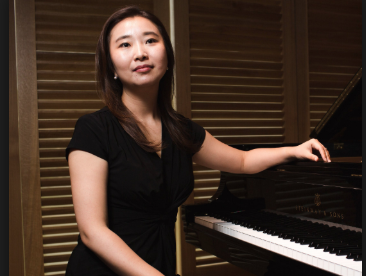Woori Kim presents Debussy Déjà Vu in Review
Woori Kim, piano
Weill Recital Hall at Carnegie Hall, New York, NY
December 26, 2018
The day after Christmas, Woori Kim presented a sophisticated program consisting of 95% Debussy, and one response to (and “continuation of”) Debussy by Canadian-born Joel Hoffman. Generally speaking, Ms. Kim’s keyboard fluency and a good ear served her well in this most demanding repertoire from the point of sonority. She captured the atmosphere of most everything on the program, but if you are a devotee of French music and Debussy is your “God,” then you know “Debussy is in the details.” Ms. Kim had some serious misreadings of phrasing, dynamics, legato, pedaling, and even chords, all of which tended to detract from the good impression she made. I am not referring to the occasional slip, which can happen to anyone. There were more than the usual amount of memory lapses, from all of which she recovered with poise.
The recital began with the elusive, mysterious second series of Images. I was concerned when the first notes of Cloches à travers les feuilles began too quickly—Debussy’s metronome marking is 92 to the eighth note, and the tempo is Lent. It sounded hurried, which deprived the music of the chance to delineate the seven (!) levels of bells that are contained in the first four measures, and farther into the piece, the space for a clear rendition of all the “small” notes. The first two chords of Et la lune descend sur le temple qui fut are marked, respectively, p and pp—there was no difference in Ms. Kim’s performance, although the mood of the movement was beautiful. Every time I was on the verge of being won over, one of these flaws would spoil my total enjoyment. Poissons d’or, the frisky portrayal of Japanese lacquer goldfish on a bowl that Debussy coveted, was played extremely fast, but again without the clarity and sparkle that a slightly more spacious tempo would have given.
Ms. Kim followed with the second book of Debussy etudes, a seriously abstract set of challenges that involve not only dexterity (which is needed to a frightening degree, and which Ms. Kim has) but subtlety of sound. Les degrés chromatiques was very well done, with super-fast lightness. I didn’t feel Debussy’s intended Italian barcarolle mood in Les agréments. Les notes répétées was very successful. Les sonorités opposées had beautiful sounds, though the distant (World War I) bugle call that occurs and recurs was not articulated in the way the composer wished, or with enough sadness, even nostalgia. Very often, when Debussy indicates diminuendo, Ms. Kim would do the opposite, or play mf when it says pp. However, on plenty of occasions in this recital I heard her do breathtaking pp, ppp, even pppp, so I know she is capable of these soft sounds. Les Arpèges composés was again, in the right mood, but lacking precise, exquisite delineation of the sound levels. Les accords was a bit sloppy for my taste. After all, these are frightfully difficult pieces (intentionally so), requiring years of living “inside” them.
The most successful piece on the program was in fact commissioned by Ms. Kim, the brand new étude: pour les symétries by Joel Hoffman. He explained in his verbal and written program notes how the human hands are symmetrical and opposite, yet how much traditional piano training has them working at cross purposes to this natural state—playing “parallel” is much harder than in contrary motion. His etude was a scintillating exploration of mirroring, and it called forth all of Ms. Kim’s brilliance. There were also slight quotes from Debussy works played elsewhere on this program. Overall, it was very exciting and intriguing. I’d like to see eleven more etudes by this composer, played by Ms. Kim, to take their place alongside the Ligeti etudes as a quality modern contribution to the genre.
After intermission, Ms. Kim gave the entire second book of Debussy Préludes, whose adventures in “whole-tone-polytonality” leave far behind everything previously done by the composer, and even predate a lot of the so-called “twelve-tone” composers. Debussy was dismantling traditional tonality in his own way—what makes it so accessible to the ear is his beautiful sonorities. Brouillards, Feuilles mortes, La terrasse des audiences au clair de lune, and Feux d’artifice were the most successful, with Les tierces alternées showing her strength in fast, light playing. In each one of these, Ms. Kim captured the perfect atmosphere, whether the solemn, enclosing mystery of fog, the introspection of autumn, moonlight bathing a sidewalk café, or Bastille Day fireworks. Elsewhere, many of the issues stated above resurfaced: when notes deliberately marked legato are played staccato, it completely changes the character and message. Something that was definitely not in Ms. Kim’s control: the dreadful out-of-tune state of the A below middle C (only after intermission), which was very apparent, as there are so many A octaves in this book of preludes.
Debussy’s scores are so detailed, it seems every single note has three or four indications for how it is to be played, how it follows what came before and precedes what comes next. This generation of French composers was really anti-interpretation. They felt that the performer should really be a talented vessel, receiving and transmitting their carefully crafted messages. Ms. Kim is very close to this ideal, and I hope she will live with all these masterworks much longer, giving them ever closer readings, refining her already considerable pianistic ability.
Her fans don’t care what I think: they rose to their feet for a standing ovation, deserved after such a strenuous program.

